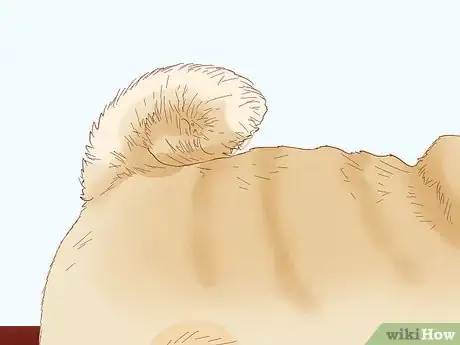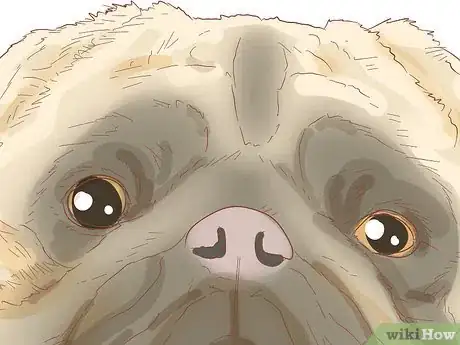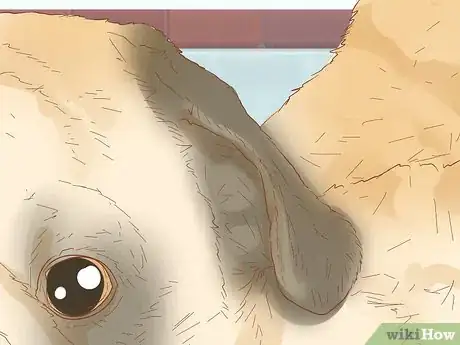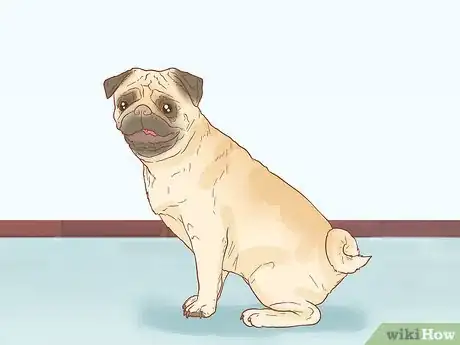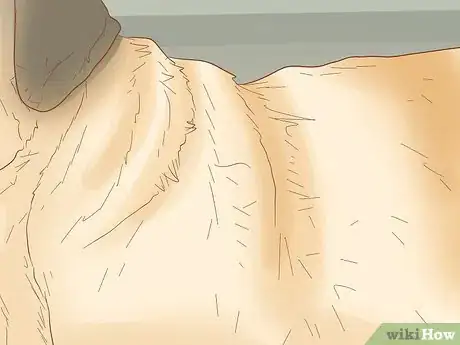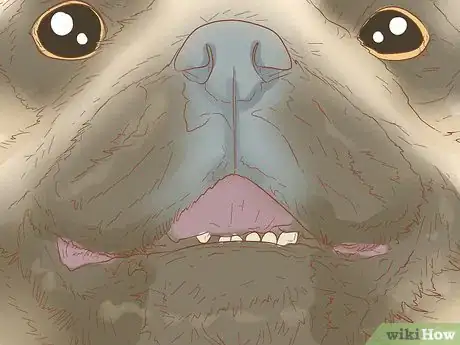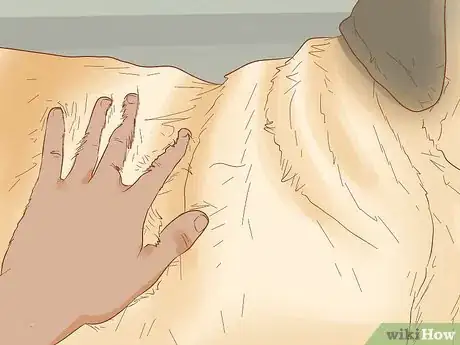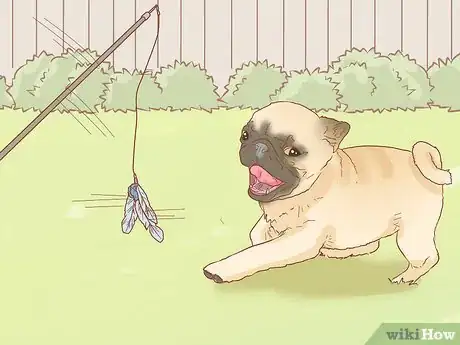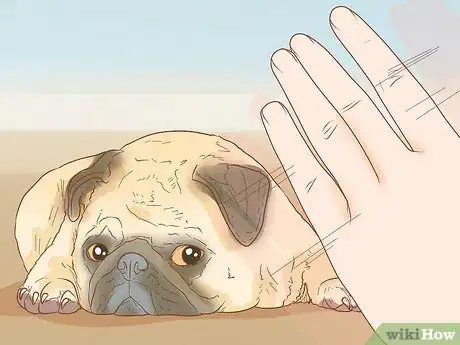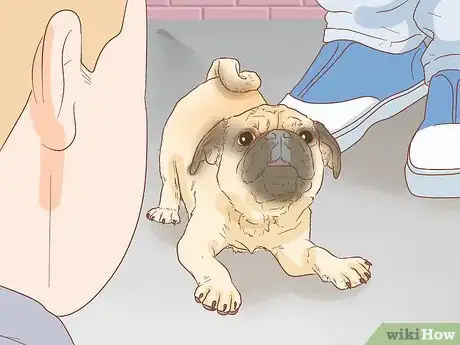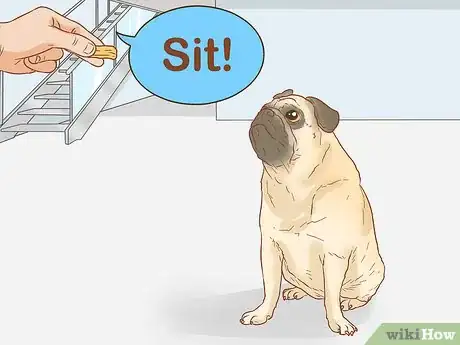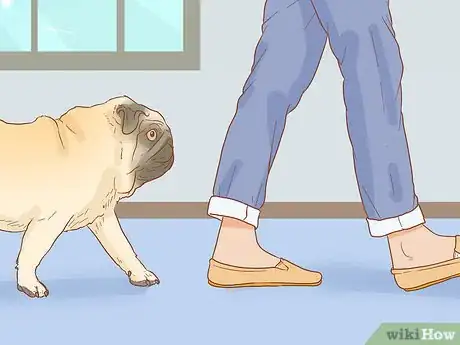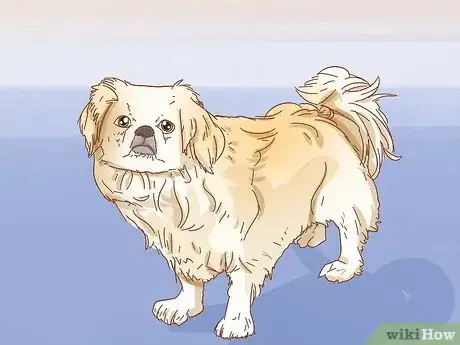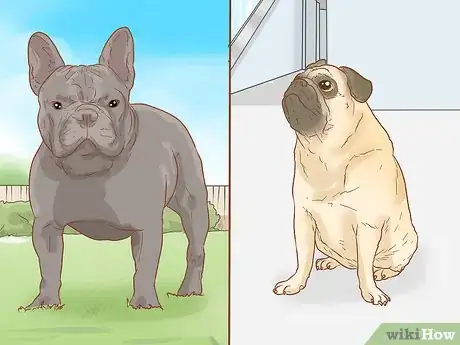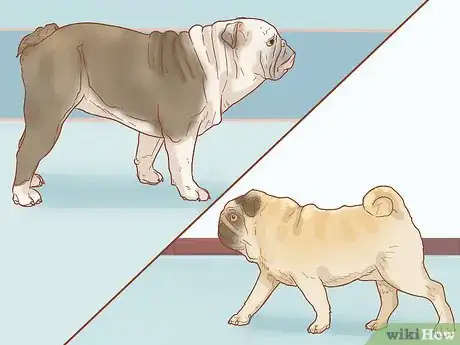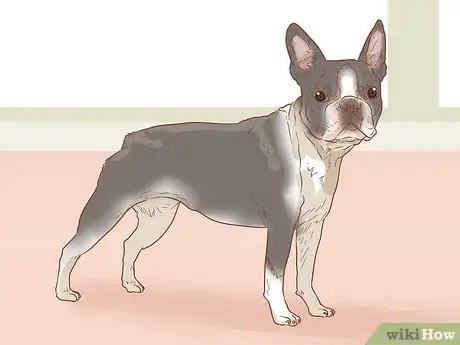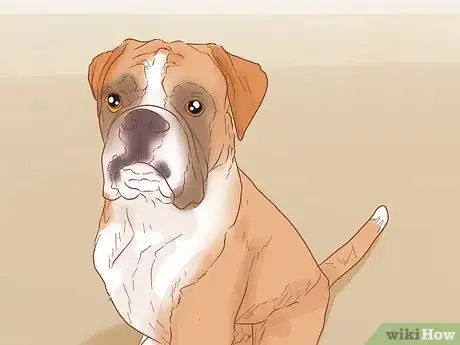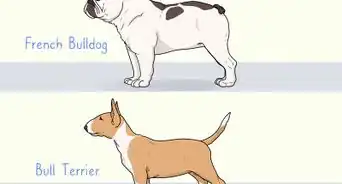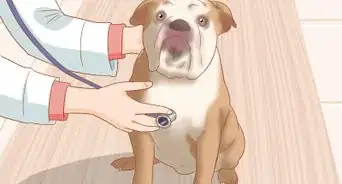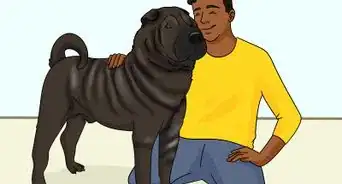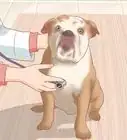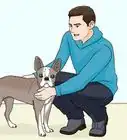wikiHow is a “wiki,” similar to Wikipedia, which means that many of our articles are co-written by multiple authors. To create this article, 11 people, some anonymous, worked to edit and improve it over time.
There are 14 references cited in this article, which can be found at the bottom of the page.
This article has been viewed 40,396 times.
Learn more...
Pugs are the largest of the toy dog breeds,[1] with a unique appearance and lovable personality. They can easily be confused with other dog breeds, however, such as a French Bulldog or Pekingese. If you take a closer look at a dog's physical characteristics and temperament, you can more easily discover whether or not the dog is a Pug.
Steps
Recognizing Body Structure
-
1Pay attention to the dog's size. Being a member of the toy group, the Pug is a smaller dog breed. They tend to weigh around 13–14 pounds (5.9–6.4 kg), standing 11–15 inches (28–38 cm) tall.[2]
-
2Look at the tail of the dog. A Pug's tail is known for being curled. The tail of a Pug should be curled (preferably double-curled) over the dog's hip tightly.[3] The tail lays upward on the edge of the back in its curled position.Advertisement
-
3Notice the dog's head shape. The AKC standards state that a Pug's head shape should be "large, massive, [and] round".[4] Pugs also have deep wrinkles on their short and flat muzzles, between their eyes, and around their faces.
-
4See if the dog has dark, prominent eyes. Pugs have round, bold eyes. Their eyes are usually a dark color, such as brown. They are large and noticeable in shape,[6] and sit across from the dark black nose.
-
5Look for small ears that rest atop the dog's head. A Pug's ears are either classified as "rose" or "button" type ears. "Rose" ears refer to small, folded ears with edges touching the side of the head. "Button" ears are not as short and are folded more forward rather than on the side of the head.[7] The AKC standards describe a Pug's ears as being similar to "black velvet".[8]
-
6See if the dog's build fits the motto multum in parvo ("a lot in a little"). A Pug's build is small, square, and muscular.[9] They have stubby and short legs. Their legs are also straight and sturdy, with shoulders that are slightly laid back and feet that are neither too round nor too long. The overall body shape of a Pug is thick and stocky.[10]
Identifying the Coat
-
1
-
2Notice black markings. If a Pug is of the fawn variety, it will have a black or brownish "mask" around its eyes and muzzle. Fawn Pugs are also seen with black dots on their cheeks and may have a black outline across their back called a "trace".[13]
-
3
Paying Attention to Temperament
-
1Look for playfulness and an overall attention-seeking, "goofy" personality, especially from younger dogs. Pugs love being the center of attention. However, as they age, their energy may slowly decrease. A Pug puppy will be after your attention and may make some trouble. They are curious and love to express their energy, and they are very eager-to-please.[16]
-
2Notice if the dog is stubborn. Pugs don't always have the easiest time listening to what they're told. If the dog likes to do what they want rather than obeying, understand that this breed of dog is naturally stubborn. Giving a Pug proper training can help it to learn how to obey commands with more ease.[17]
-
3Watch for a guarding ability. Pugs make great watchdogs. They are attentive and will do what they can, despite their small size, to remain loyal and protecting of their owners. This is a desirable trait found in a dog.[18]
-
4Pay attention to the dog's intelligence. Along with being protective, Pugs are smart dogs. They are fairly intelligent, which helps them with their guarding abilities. See how clever the canine is to help determine if they may be a Pug.[19]
-
5See if an older dog appears more docile. If the dog is older, rather than being energetic, it may be more willing to follow your directions. As they age, a Pug may become more accepting of human control.[20]
Being Aware of Similar Breeds
There are several other dog breeds that have similarities in appearance to a Pug. However, if you are aware of the differences between the breeds, you can obtain a better understanding of whether or not a dog is a Pug.
-
1Know the differences between a Pug and a Pekingese. A Pekingese can seem exactly like a Pug, especially if it has a short coat. Most Pekingese, however, have quite long fur. Both breeds have wrinkles and flat muzzles, but a Pekingese's tail won't be curled like a Pug's - instead, it hangs over the dog's back. Pekingese can also come in different coat colors than Pugs, though both can be seen in fawn and black. Despite having longer fur, Pekingese don't shed as much as Pugs, but still a moderate amount.[21]
-
2See how French Bulldogs and Pugs differ. French Bulldogs are another popular breed with wrinkles and a flat muzzle. They are slightly bigger than Pugs (and therefore not a member of the toy group) and have short, stubby tails. Their ears are perked, rather than the pug's folded ears. A solid black or tan and black Frenchie may have white markings on the chest or stomach, differentiating it from a Pug.[22]
-
3Understand the differences between Pugs and Bulldogs. Two stubborn, flat-faced breeds, Pugs and English Bulldogs have a lot in common. For example, both have faces coated with wrinkles. However, Bulldogs have short, stumpy tails, while pugs have longer, curled tails. Bulldogs can come in many more color varieties, such as brown or brown with white markings. Pugs are smaller than Bulldogs, as Bulldogs are members of the non-sporting group. Bulldogs also have different ears than Pugs.[23]
-
4Spot differences between Boston Terriers and Pugs. These two breeds are roughly equal in size and body structure. However, Boston Terriers usually have perked up ears and stubby tails, and they tend to be black and white, while black Pugs aren't seen with white markings. They also have completely different origins - Boston terriers originate in the United States, while Pugs date back to Ancient China.[24]
-
5Notice how Pugs and Boxers differ. Boxers are medium-sized dogs and larger than Pugs, but the two both tend to have flat, black muzzles. A Boxer can have either cropped or uncropped ears, along with a natural or docked tail. A Boxer's natural tail is longer than a pug's and isn't curled, while the docked tail is very short. Boxers are usually brown or black in color, but also are seen in white, brindle, and more color variants. Pugs aren't typically seen in a brown coat.[25]
-
6Be aware of how Pugs and Bullmastiffs differ. Pugs and Bullmastiffs may look a little similar in appearance, but Bullmastiffs are much larger dogs. Pugs are small dogs (generally lap dogs), while Bullmastiffs are large dogs sometimes used for guarding. Bullmastiffs have long tails that don't curl over their backs. Both dogs have wrinkles, but Bullmastiffs have usually larger muzzles.[26]
Expert Q&A
-
QuestionDoes a dog's breed solely determine its personality traits?
 Elisabeth WeissElisabeth Weiss is a Professional Dog Trainer and owner of Dog Relations NYC, a dog training service in New York, New York. Elisabeth relies on science-based, force-free, and reward-based techniques. Elisabeth offers behavior training, puppy manners, body awareness and injury prevention, diet, exercise and dog nutrition services. Her work has been featured in New York Magazine and on the Dog Save the People podcast. She also trained all the dogs in the movie "Heart of a Dog" by Laurie Anderson that features Elisabeth's journey with Laurie Anderson's and Lou Reed's dog Lolabelle and how her passion for playing the keyboards played a significant role in improving her quality of life after being diagnosed with pancreatic cancer.
Elisabeth WeissElisabeth Weiss is a Professional Dog Trainer and owner of Dog Relations NYC, a dog training service in New York, New York. Elisabeth relies on science-based, force-free, and reward-based techniques. Elisabeth offers behavior training, puppy manners, body awareness and injury prevention, diet, exercise and dog nutrition services. Her work has been featured in New York Magazine and on the Dog Save the People podcast. She also trained all the dogs in the movie "Heart of a Dog" by Laurie Anderson that features Elisabeth's journey with Laurie Anderson's and Lou Reed's dog Lolabelle and how her passion for playing the keyboards played a significant role in improving her quality of life after being diagnosed with pancreatic cancer.
Professional Dog Trainer A dog's personality depends on the individual dog and what type of environment they are in rather than what type of breed they are.
A dog's personality depends on the individual dog and what type of environment they are in rather than what type of breed they are. -
QuestionWho says pugs are the biggest of the toy breeds? Please clarify and justify this claim.
 Community AnswerAs with all wikiHow articles, citations are provided; simply click on the number next to the data in the article to see its source. The indexed reference at the end indicates that this information comes from pawster.com/pug/.
Community AnswerAs with all wikiHow articles, citations are provided; simply click on the number next to the data in the article to see its source. The indexed reference at the end indicates that this information comes from pawster.com/pug/. -
QuestionIs it difficult to identify a pug if it has a straight tail?
 LinnieTop AnswererPugs usually have, and are bred to inherit, curly tails. However, in certain circumstances, a pug's tail may appear straight, such as if it is a newborn puppy or in its senior years, if it has an illness of some sort, if it is experiencing emotional distress, or if it was poorly bred. Having a straight tail would not make a pug too difficult to identify though, as pugs have several other distinguishing traits, including their flat muzzles and facial wrinkles.
LinnieTop AnswererPugs usually have, and are bred to inherit, curly tails. However, in certain circumstances, a pug's tail may appear straight, such as if it is a newborn puppy or in its senior years, if it has an illness of some sort, if it is experiencing emotional distress, or if it was poorly bred. Having a straight tail would not make a pug too difficult to identify though, as pugs have several other distinguishing traits, including their flat muzzles and facial wrinkles.
References
- ↑ https://pawster.com/pug/
- ↑ http://pugtips.com/pug-appearance/
- ↑ http://images.akc.org/pdf/breeds/standards/Pug.pdf
- ↑ http://images.akc.org/pdf/breeds/standards/Pug.pdf
- ↑ https://www.akc.org/dog-breeds/pug/
- ↑ http://images.akc.org/pdf/breeds/standards/Pug.pdf
- ↑ http://pugtips.com/pug-appearance/
- ↑ http://images.akc.org/pdf/breeds/standards/Pug.pdf
- ↑ https://www.akc.org/dog-breeds/pug/
- ↑ http://images.akc.org/pdf/breeds/standards/Pug.pdf
- ↑ https://pugshome.com/different-colors-pugs/
- ↑ http://images.akc.org/pdf/breeds/standards/Pug.pdf
- ↑ http://images.akc.org/pdf/breeds/standards/Pug.pdf
- ↑ https://www.yourpurebredpuppy.com/reviews/pugs.html.
- ↑ http://images.akc.org/pdf/breeds/standards/Pug.pdf
- ↑ http://pugtips.com/breed-temperament/
- ↑ http://pugtips.com/breed-temperament/
- ↑ https://www.i-love-pugs.com/pug-personality.html
- ↑ http://pugtips.com/breed-temperament/
- ↑ http://pugtips.com/breed-temperament/
- ↑ https://dogbreedatlas.com/dog-breed-comparison-tool&pug-vs-pekingese
- ↑ https://dogell.com/compare-dog-breeds/pug-vs-french-bulldog
- ↑ https://www.barkblaster.com/blog/pug-vs-bulldog-dog-best
- ↑ https://www.dogbreeds911.com/boston-terrier-vs-pug.html#size
- ↑ http://www.dogbreeds911.com/pug-vs-boxer.html
- ↑ https://dogbreedatlas.com/dog-breed-comparison-tool&bullmastiff-vs-pug

